| Author |
 Topic Topic  |
|
Xavier
Scientific Collaborator
    
France
12205 Posts |
 Posted - 03/02/2017 : 14:04:25 Posted - 03/02/2017 : 14:04:25



|
 You allways answer close to the question. It is tired, Tomas. You allways answer close to the question. It is tired, Tomas.
As usual, you see only your interest. |
Edited by - Xavier on 03/02/2017 14:12:38 |
 |
|
|
Francesco
Forum Admin
    
Luxembourg
9454 Posts |
 Posted - 03/02/2017 : 14:32:37 Posted - 03/02/2017 : 14:32:37




|
quote:
Originally posted by horshehden
In most cases, Ranong, Saraburi etc should be interpreted as Cameron Highlands; collecting date might be correct.
Sure Tomas, but the Science uses "interpretation" only for discussions, never for data.
In this case, the right word is "speculation" not "interpretation".
Original data must be stable.
They can not be object of speculation.
A serious author who has news of or detects errors (now, we can say "evident errors") concerning the original locality of his types is obliged to write a correction.
Otherwise, he is slob.
The goal of Entomology and of Science is the Social Utility, not impressing people with his own descriptions, as some pathetic loser thinks and thought in the past. |
 |
|
|
Xavier
Scientific Collaborator
    
France
12205 Posts |
 Posted - 03/02/2017 : 14:55:01 Posted - 03/02/2017 : 14:55:01



|
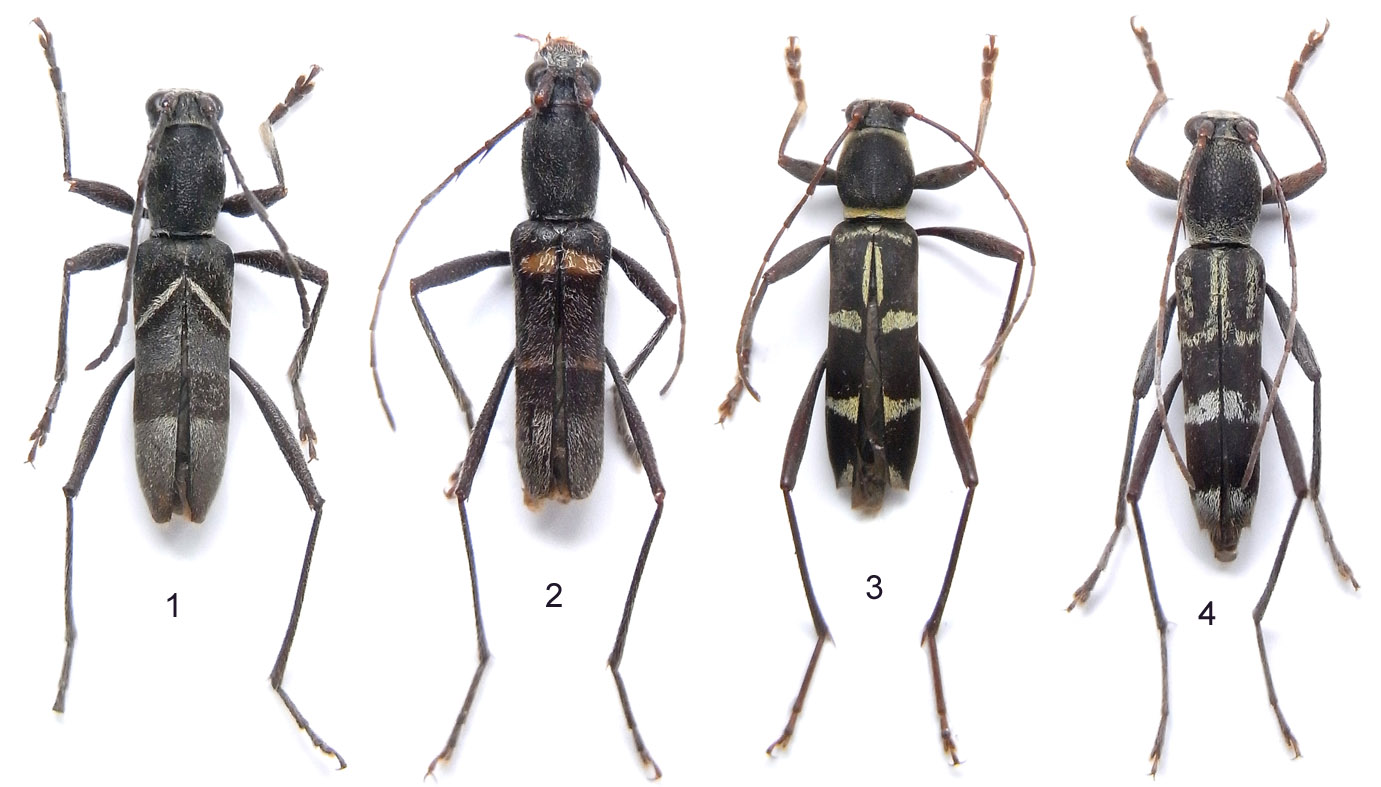
190.93 KB
Those 4 specimens, just prepared for you, dear forum members, all come from Thailande, Saraburi, XI.1988. 
After a quick ID session:
1. Demonax polyzonus Pascoe, 1869. Species described from Borneo.-> Demonax belumensis Viktora, 2020 Malaisie(Perak)
2. Demonax transversalis Aurivillius, 1910. Species described from Borneo. -> It seems to be Demonax machi Viktora, 2020 described from Malaysia(Perak) !
3. Rhaphuma brevivittata (Aurivillius, 1922). Species described from West Malaysia.
4. Demonax drescheri Fisher, 1936 ? Species described from Java.
It clearly means that all species described by Holzschuh with exactly same data can come from everywhere around "Malaysia". |
Edited by - Xavier on 11/10/2020 10:39:48 |
 |
|
|
horshehden
Member Purpuricenus
 
Czech Republic
424 Posts |
 Posted - 03/02/2017 : 22:54:27 Posted - 03/02/2017 : 22:54:27



|
Ok:
1. go to the seller
2. ask her for the name of the collectors
3. find the collectors (if still alive)
4. ask where they collected these beetles
5. publish the right place
OR
1. gather sufficient material from "Saraburi" and Cameron Highlands and possibly other areas
2. analyse all the features you can imagine, including DNA
3. publish your findings
I cannot suggest you anything more. Otherwise you can never be sure from where the specimens came from.
Using my knowledge of the region I suggested that the locality should be interpreted (==read, understand, ..) as Cameron Highlands. Nothing more (I did not use corrected), nothing less (I'm not speculating).
Speculation is creating a hypothesis with really a little evidence - such as the one created by Xavier that "Saraburi" species are identical with Bornean species or the one that it is funny to see Bornean subspecies of Thai species.
However, my speculation is that most of the species described from "Saraburi" or "Ranong" indeed occur in southern Thailand (and may be even in Ranong area) since there is the same type of forest on both sides of the border (and very different to northern Thailand or Laos). |
 |
|
|
horshehden
Member Purpuricenus
 
Czech Republic
424 Posts |
 Posted - 03/02/2017 : 23:02:14 Posted - 03/02/2017 : 23:02:14



|
quote:
Originally posted by Xavier
 You allways answer close to the question. It is tired, Tomas. You allways answer close to the question. It is tired, Tomas.
As usual, you see only your interest.
What do you actually expect?
First you write 'If you know something, publish it'. So I answered your question on Oligoenplus saying 'wait until I find the solution'.
And you complain again...and again you overlook the species from Sumatra. If there is different, but very close species in Sumatra, why not having another one in Borneo? |
 |
|
|
Xavier
Scientific Collaborator
    
France
12205 Posts |
 Posted - 03/02/2017 : 23:35:04 Posted - 03/02/2017 : 23:35:04



|
Thanks for all your propositions. Me, I have no available answer.
But :
- We have just here about 40 homeless species, with no homeland.
- I have no way to check anything about Holzschuh's species, and I will not do anything for that: it is his problem, not mine.
- What do I actually expect ?
This post has been read more than 700 times (and your answers too  ). I just hope that those fake data are known, now. ). I just hope that those fake data are known, now. |
Edited by - Xavier on 03/02/2017 23:52:16 |
 |
|
|
Francesco
Forum Admin
    
Luxembourg
9454 Posts |
 Posted - 04/02/2017 : 09:21:50 Posted - 04/02/2017 : 09:21:50




|
The situation is not so simple, Tomas.
quote:
1. go to the seller
The seller is no longer present in Thailand. Her brother was killed and she went back to the country. Where?
quote:
2. ask her for the name of the collectors
3. find the collectors (if still alive)
4. ask where they collected these beetles
It is about specimens "collected" about 30 years ago, presumably by indigenous collector(s), I wonder if she remembers their names...
...unless, a fraud is hidden inside (as we have evidence). That could have legal consequences.
In both cases, I strongly doubt that the real name of the collector(s) can be discovered.
quote:
Using my knowledge of the region I suggested that the locality should be interpreted (==read, understand, ..) as Cameron Highlands. Nothing more (I did not use corrected), nothing less (I'm not speculating).
Speculation is creating a hypothesis with really a little evidence
Exactly, your hypothesis is really a speculation.
Why Cameron Highlands (Pahang)?
Why not Fraser Hill (Pahang)? or Sabah (Borneo)?
Xavier showed that photo 2 shows Demonax transversalis Aurivillius, 1910, a Bornean endemism.
If we consider Saraburi as Cameron Highlands, we are authorised to record Demonax transversalis from Peninsular Malaysia.
But this is only your speculation!
The only thing we know is that Saraburi is a false locality!
And this is because somebody "collected" there only species coming from far localities in impossible periods of time! 
quote:
most of the species described from Saraburi or Ranong indeed occur in southern Thailand (and may be even in Ranong area) since there is the same type of forest on both sides of the border (and very different to northern Thailand or Laos)
This is absolutely false.
Saraburi is far from the mountains connecting Malaysia, Myanmar, North Thailand, Vietnam and Laos.
I could expect mountain Malayan species in North Thailand, not in Saraburi.
In fact, if you read the Chrysomelidae collected in Saraburi here and here, there is no Bornean species present in Saraburi (unless widespread banal species).
Consequently, all species described from Saraburi are "incertae patriae" and under examination. |
 |
|
|
Xavier
Scientific Collaborator
    
France
12205 Posts |
 Posted - 04/02/2017 : 10:16:50 Posted - 04/02/2017 : 10:16:50



|
The German seller told me that she has sold 250 specimens, and she will buy more blisters and sell them soon on ebay.
If you want to buy extroardinany vintage material from Thailand, I give you her name by mail  . Me, I do not want more... . Me, I do not want more... 
...but you, Tomas ? ( and I am very serious ) |
Edited by - Xavier on 04/02/2017 10:18:22 |
 |
|
|
Xavier
Scientific Collaborator
    
France
12205 Posts |
 Posted - 04/02/2017 : 14:42:18 Posted - 04/02/2017 : 14:42:18



|
Casiphia inopinata Hüdepohl, 1998 is a very nice species. Here a picture.
A Lao friend, who wrote a paper about this species few years ago, told me that specimens from Chiang Mai (North Thailand) have ...fake data and they come from north Laos (and I remember when I caught my first one  in Houa Phan). in Houa Phan).
But maybe somebody here collected Casiphia inopinata in north Thailand???
After these "data", specimens have been found in Yunnan and Burma. So, once again, nothing can be proved.
If you read Hüdepohl (1998), you will "discover" that the holotype from Chiang Mai is located in ...Collection Sabine Steinke, Lünen = the farm of Saraburi, Thailand  . .
Of course, August 1988 is a fake date: no Casiphia in full rainy season!
It is a Spring species from April-May.
August ...should the month of the purchase.
P. Viktora told me: "Steinke" is a well known old problem.
Sorry for having discovered this problem today !...
I guess that Herr Steinke bought material in south (road to Malaysia) or Chiang Mai (north, road to Laos), every time he had to cross the border for a new visa (as all strangers do in Thailand, every 6 months)  ...but this is a pure speculation ...but this is a pure speculation  |
Edited by - Xavier on 04/02/2017 15:26:16 |
 |
|
|
Xavier
Scientific Collaborator
    
France
12205 Posts |
 Posted - 04/02/2017 : 16:46:03 Posted - 04/02/2017 : 16:46:03



|
to follow this incredible story , have a look here
   |
 |
|
|
Xavier
Scientific Collaborator
    
France
12205 Posts |
 Posted - 04/02/2017 : 17:33:43 Posted - 04/02/2017 : 17:33:43



|
| and here |
 |
|
|
Xavier
Scientific Collaborator
    
France
12205 Posts |
 Posted - 20/02/2017 : 11:17:52 Posted - 20/02/2017 : 11:17:52



|
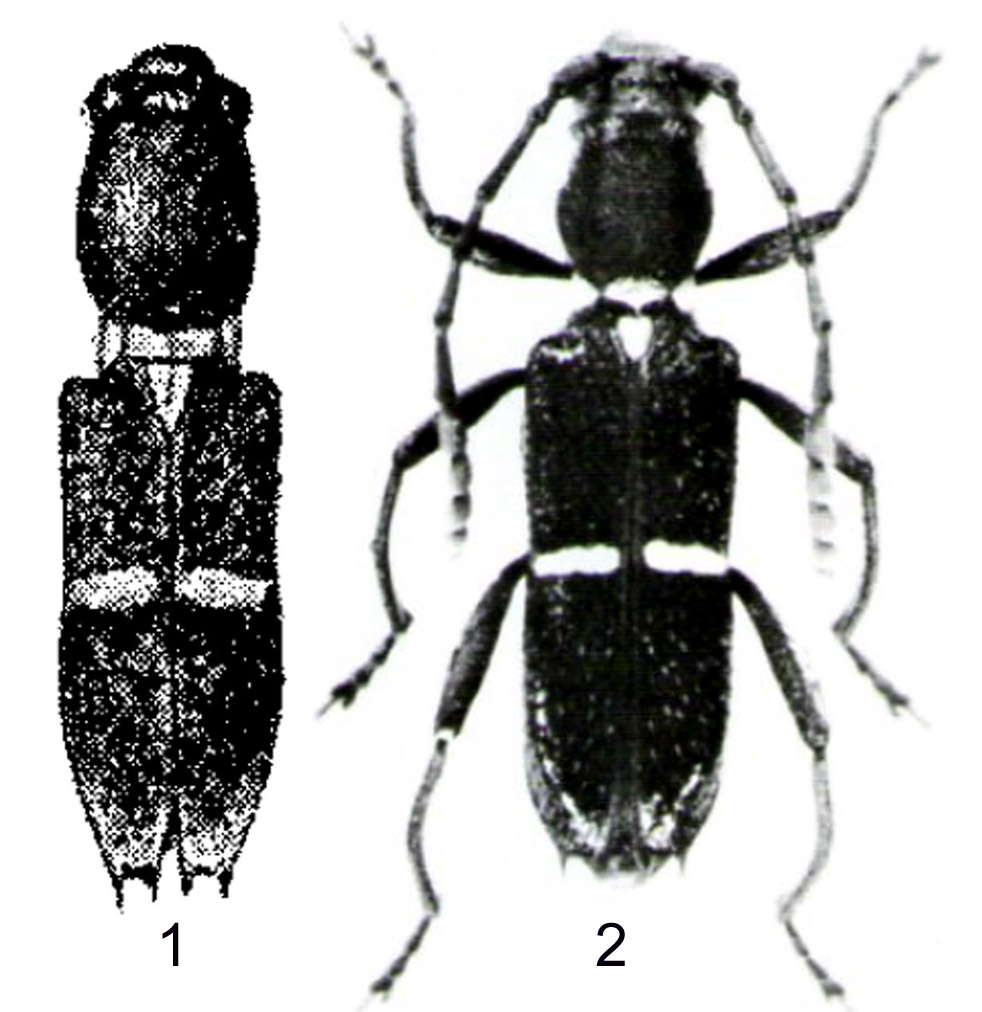
170.55 KB
Photo1.Centrotoclytus asperatus Aurivillius, 1925 is from Borneo.
Photo2.Centrotoclytus curvipes Holzschuh, 1992 is from Thailand, Ranong, Jan.-Mar, 1989
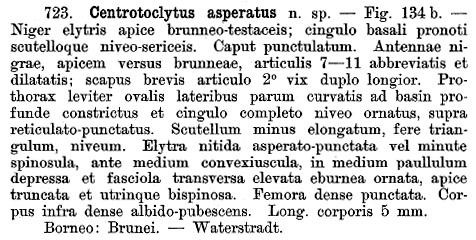
86.9 KB
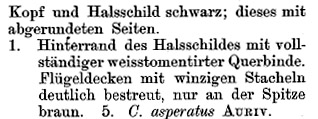
42.09 KB
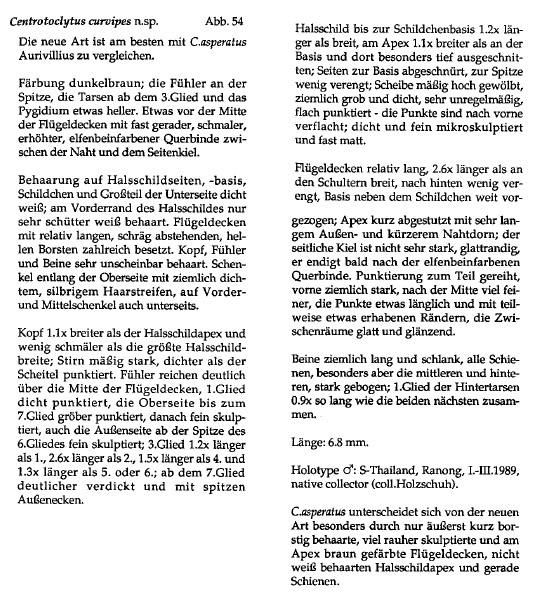
178.56 KB
I do not read German langage (sorry). Who can help me to understand the differencial diagnose proposed by the second author ? Thanks. |
 |
|
|
Francesco
Forum Admin
    
Luxembourg
9454 Posts |
 Posted - 20/02/2017 : 12:49:36 Posted - 20/02/2017 : 12:49:36




|
C. asperatus differs from the new species especially in the elytra shortly setaceous pubescent externally, much coarsely sculptured, brown at apex; the apex of the pronotum not covered with white pubescent, and the straight tibiae.
The elytral apex looks brown in this species as well, however... |
 |
|
|
Xavier
Scientific Collaborator
    
France
12205 Posts |
 Posted - 20/02/2017 : 12:52:13 Posted - 20/02/2017 : 12:52:13



|
| Ok, thanks a lot. |
 |
|
|
Xavier
Scientific Collaborator
    
France
12205 Posts |
 Posted - 10/03/2018 : 12:29:12 Posted - 10/03/2018 : 12:29:12



|
The problem is larger than Cerambycid-group.
In those 3 papers, available on internet, you will find other fakes data by searching (crtl + f ) "Saraburi" or "Steinke". Often, the authors note the inexplicable distribution of a species. Now they have their answer to this mystery.
- GIUSEPPE PLATIA, 2008. Contribution to the knowledge of the species of the genera Agonischius Candčze and Vuilletus Fleutiaux (except those from Japan and Taiwan) (Coleoptera, Elateridae, Elaterini) Boletín Sociedad Entomológica Aragonesa, n1 42
- MICHAEL GEISER, 2010. Studies on Prionoceridae (Coleoptera: Cleroidea). II. A revision of the genus Prionocerus Perty, 1831. Zootaxa 2328: 1–48
- J. HÁJEK, 2009. Revision of the genus Eulichas Jacobson, 1913 (Coleoptera: Eulichadidae) II. E. dudgeoni species group. Zootaxa 2192: 1–44
...but the list should be longer  . .
|
Edited by - Xavier on 10/03/2018 12:29:46 |
 |
|
 Topic Topic  |
|
|
|


